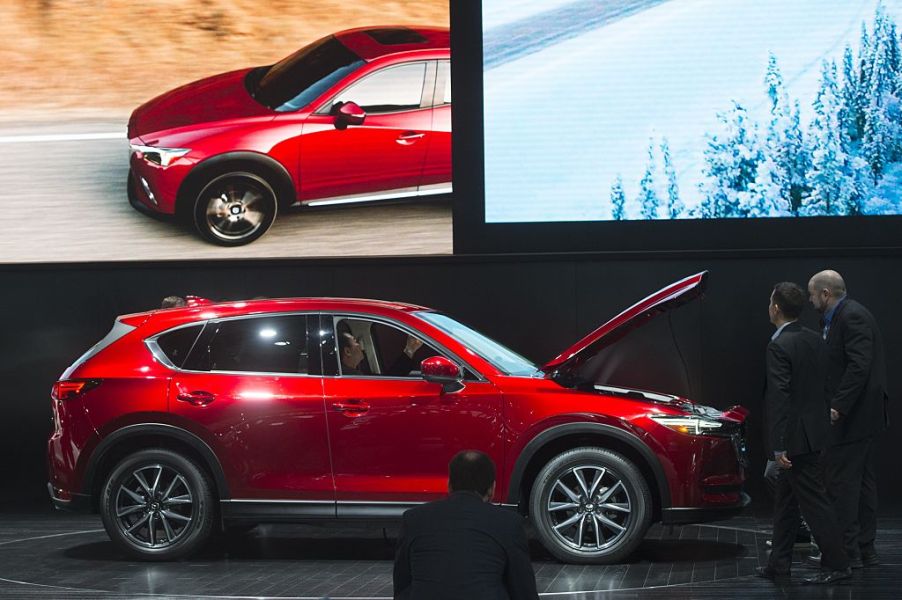
The Most Common Mazda CX-5 Owner Complaints
Mazda has built some pretty decent vehicles over the years. Many feel they produce some reliable vehicles, and they do. But are all of their products problem-free? Not exactly. As you see with many other vehicle manufacturers, some models fall short of people’s expectations. The Mazda CX-5 is one of its products that did just that for both the 2015 and 2016 model years. CarComplaints.com shows us the three most common complaints that owners had about those particular models.
Daytime running lights for the 2016 Mazda CX-5
The Mazda CX-5 has stood up well to its competitors, but it has had some frustrating issues to contend with. One of the most common complaints owners reported on the site was about the daytime running lights, specifically the LED units. Those who purchased a 2016 model complained that these lights didn’t last long at all.
They would start flickering continuously without warning and then quit working altogether. Generally, they’re rated to last the life of the car. But for this model, people reported that they had to replace them with well under 100,000 miles on the vehicle.
This is an issue because Mazda designed them to be all one unit. You can’t just replace a bulb like you would on a lot of older vehicles. These days, many automakers use the bulb and casing fused together. The all-in-one part isn’t cheap, though. Those who had to replace them spent $1,000 and up to have a new one installed. Many owners found that it wasn’t under warranty coverage either since most of them are only good for about 36,000 miles or a few years.
However, there’s some good news about this problem. In 2020, Mazda released a recall for the LED units. They figured out, according to Consumer Reports, that they used an improperly made gasket that would emit sulfur into the assembly. This would cause corrosion within the wiring, which caused the flickering and would lead to the bulb to stop working. The recall allows for the installation of newer units and for reimbursement for those who had to incur the cost out of their own pockets.
Cracking windshields on the 2015 Mazda CX-5
Owners of the 2015 Mazda CX-5 reported a frustrating issue with their windshields breaking easily. Some said road debris hit the glass, which should only cause a nick or slight dent on other windshields. With this model of the CX-5, it would cause extensive damage. Cracks would show up to be anywhere from two feet long to several feet, stretching from one end of the glass to the other.
When drivers took their vehicles in to get it repaired, they were told that they would have to have the whole windshield replaced. Sometimes, this wouldn’t be that much of an issue, but with the CX-5, because of the sensors embedded in the glass for the lane-centering feature, it would have to be an OEM product. Of course, that means that you would pay significantly more for the job. The cost to have a new one installed was anywhere from $700-$1,200.
Mysterious windshield damage on the 2016 model
The 2016 model also received many complaints against the windshield. However, this model has one strange difference to it. Instead of small rocks causing tons of damage, cracks would come out of the woodwork, so to speak, for no apparent reason. Owners would park their car with a perfectly fine windshield, only to come back an hour or so later and find cracks from nowhere. No dents or chips on the glass, so they couldn’t have come from rocks or other debris being thrown at it.
Some even reported that the cracks showed up right in front of their eyes as they were driving down the road. They said they first heard some cracking and popping noises, and then they saw the cracks form. Again, nothing hit the windshield before the noises.
Like the previous model, the sensitive equipment installed within the glass causes replacements to be very expensive. Some owners had to pay the deductible cost, which was around $500 for some. But others without glass insurance saw repair bills upwards of a thousand dollars.
Many people seemed pleased with their CX-5 as it performed well for the most part. But, there were a few others that were so turned off by these three annoying problems that they had no plans to upgrade to a newer model. They sought more reliable brands instead. If the CX-5 is on your vehicle wish list, you might want to avoid the 2015 and 2016 models as they seem to have the most complaints.


